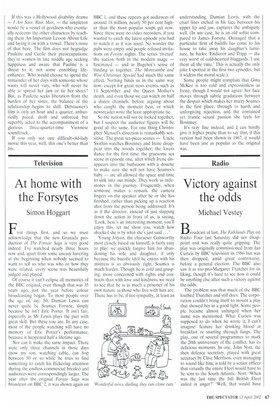Television
At home with the Forsytes
Simon Hoggart
First things first, and so we must acknowledge that the new Granada production of The Fors-yte Saga is very good indeed. I've watched nearly three hours now and, apart from some uneasy havering at the beginning when nobody seemed to want to tell us who was who or how they were related, every scene was beautifully judged and played.
Of course it can't eclipse all memories of the BBC original, even though that was 35 years ago, just the year before colour broadcasting began. To most people over the age of, say, 50, Damian Lewis can never quite be Soames Forsyte, simply because he isn't Eric Porter. It isn't fair, especially as Mr Lewis plays the part with great skill. But there you are. In any case, most of the people watching will have no memory of Eric Porter's performance, because it happened half a lifetime ago.
Nor can it make the same impact. There were only three channels in those days (now my son, watching cable, can hop between 50 or so while he tries to find something to catch his flickering attention during the endless commercial breaks) and audiences were correspondingly larger. The year after the original Forsyte Saga was broadcast on BBC 2, it was shown again on BBC 1, and these repeats got audiences of around 18 million, nearly 50 per cent higher than the most popular soaps get now. Since there were no video recorders, if you wanted to catch the latest episode you had to watch it as it was aired. No wonder the pubs were empty and people refused invitations on Forsyte nights. The series 'riveted' the nation, both in the modern usage — fascinated — and in Bagehot's sense of binding us together. The Morecambe and Wise Christmas Special had much the same effect. Nothing binds us in the same way now, except for great news events, such as 11 September and the Queen Mother's death, and even those we can watch on half a dozen channels, before arguing about who caught the moment best, or which newsreader wore the least appropriate tie.
So the nation will not be locked together, but I suspect the audience figures will be good all the same. For one thing Christopher Menaul's direction is remarkably sensitive. The great set-piece scenes — Uncle Swithin watches Bosinney and Irene disappear into the woods together; the lovers dance for the first time; the gruesome sex scene in episode one, after which Irene disappears into the bathroom with a douche to make sure she will not have Soames's baby — are all allowed the space and time to sink into our minds. They work as milestones in the journey. Frequently, when someone makes a remark, the camera lingers on the speaker after he or she has finished, rather than picking up a reaction shot from the person being addressed. It's as if the director, instead of just slapping down the action in front of us, is saying, 'Look, here's an interesting moment, you'll enjoy this, let me show you, watch how shocked she is by what she's just said ...
Young Jolyon, the character Galsworthy most closely based on himself, is fairly easy to play; we quickly forgive him for abandoning his wife and daughter, if only because the bucolic idyll he enjoys with his mistress is so obviously right. Soames is much harder. Though he is cold and grasping, more concerned with rights and contracts than with love and kindness, we need to see that he is as much a prisoner of his own nature as those who live with him are. There has to be, if not sympathy, at least an understanding. Damian Lewis, with the cruel lines etched in his face. between his upper lip and jaw, captures the ambiguity well. (In any case, he is an old softie compared to James Forsyte. Outraged that a particular firm of bailiffs has come to his house to take away his daughter's furniture, he barks: 'Endicoot and Tripp — the very worst of cold-hearted blaggards. I use them all the time.' This is actually the only joke I spotted in the first two episodes, but it widens the moral scale.) Some people might complain that Gina McKee is too cold and expressionless as Irene, though I would not agree: her face moves through subtle gradations between the despair which makes her marry Soames in the first place, through to harsh and unforgiving rejection, and the contained yet frantic sexual passion she feels for Bosinney.
It's very fine indeed, and I can hardly give it higher praise than to say that, if this version had been shown in 1967, it would have been just as popular as the original was.


















































































 Previous page
Previous page